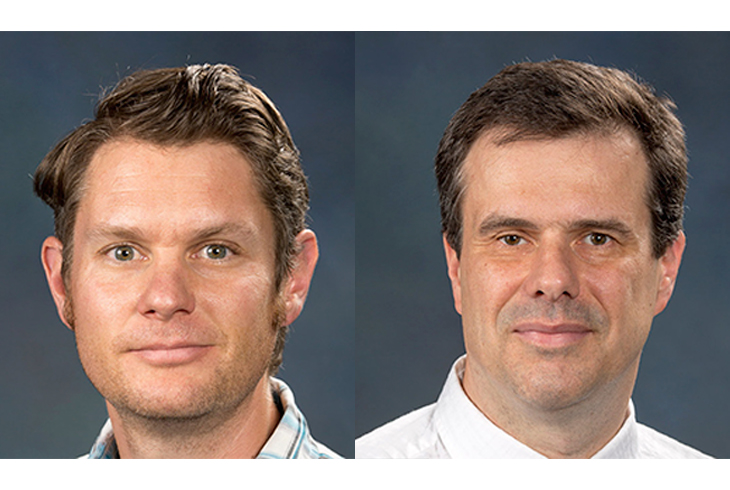Recently Andrew Sutton and Mylan Sykora, Los Alamos National Laboratory scientists in the inorganic isotope and actinide chemistry division were selected to participate in the first Innovate New Mexico Showcase. They joined scientists from Air Force Research Laboratory, New Mexico State University, New Mexico Tech and Sandia National Laboratories to present their work to investors.
This showcase was not the beginning of the journey for Sutton, Sykora and Sykora’s research partner, Igor Usov. Rather, it started last year with their participation in the first DisrupTECH, an event designed to spark the entrepreneurial spirit of Los Alamos scientists by coaching them on how to reframe their technologies to solve a problem outside of a research setting.
Sutton and Sykora were asked what they’ve learned from their experiences with DisrupTECH and Innovate NM.
What do you do at Los Alamos?
Sutton: I have been a chemist at Los Alamos for nine years. The goal of my organization is developing energy sources to replace fossil fuels and my specific scientific work is focused on catalysis for energy applications.
Sykora: I work in the same organization as Andy so our overall goal is the same—to replace fossil fuels. However, I am a physical chemist working on developing materials for energy conversions and storage. Igor Usov (who is in the Engineered Materials division) and I have been doing collaborative research with thin film development working with uranium. He is developing the materials while I characterize the material and develop devices to deploy it.
What technology did you present?
Sutton: My team has been pursuing low-temperature, efficient conversion of biomass to chemicals and fuels for several years and we have developed a variety of new pathways. Our recent work converts a small building block molecule into several products—paint additives, chemical solvents and chemical precursors using a handful of simple chemical transformations with cheap catalysts. As it’s a single pathway we can alter the reaction conditions to adjust the chemicals produced dependent on market demand. To increase robustness in our process we can also produce both diesel and gasoline components.
Sykora: Depleted uranium oxide (DUO) is an abundant and cheap waste product of the nuclear fuel enrichment process. Its supply will grow with the expected growth of the nuclear energy industry. The Department of Energy is looking for solutions to reduce the stockpile. DUO films use the depleted uranium oxide and have properties appealing for use in low-cost optoelectronic devices (solar cells, detectors, etc.) particularly for use in harsh environments.
Why did you decide to participate in DisrupTECH and Innovate NM?
Sutton: I wanted to learn more about industry needs and understand better how new technology gets adopted. I really wanted to see what we needed to demonstrate in the lab to get the technology ready for larger scale adoption. I was also intrigued to see if we could get someone interested in our research and technology.
Sykora: Most funding we get is for the early stage research to prove a concept. It is much harder to get funding to develop a prototype to demonstrate proof-of-concept and beyond. We focus so much on basic research that we are not good at understanding what’s needed to get the technology to application. I wanted to understand how to do this better.
What did you get out of DisrupTECH and Innovate NM?
Sutton: It’s helped me shift through my thought process on how to present my research to different audiences. When you present to an academic audience you need to present the science behind your research. When presenting to potential funders and technology adopters the focus changes to letting them know how your technology is going to solve an existing problem. The best way I can describe it is looking at the difference between Albert Einstein and Bill Gates. Both developed two major disruptive technologies: Einstein’s was a major scientific discovery and Gate’s was an application that has changed how we work and live in today’s society.
Sykora: It really helped us understand what we need to focus on developing next and the steps we need to take to get there. This change is an adjustment in how we think about the problem and what the market really needs us to solve with our technology.
What do you see as next steps for your technologies?
Sutton: At this point, finding partners with the experience to help move our technology forward is a priority.
Sykora: Our immediate goal is to develop a first prototype of a DUO photodiode. If we are successful, this should open doors to many other optoelectronic applications of DUO.
* * *
One of the greatest benefits to have Los Alamos technical staff take part in DisrupTECH and the Innovate New Mexico showcase is the opportunity to present their technologies to an entirely different audience unlike the ones they are used to. Presenting to a business-oriented group brings an entirely different level of exchange that can be extremely useful. Sutton and Sykora both added that through this process they learned the importance of moving from basic science toward applied science in order to make the transition to the marketplace a reality. This, of course, is the challenge all innovators face. Whether the work starts in the nation’s DOE laboratories, in other sectors of government, or in industry, all face the same hurdle: Turning that big idea into a tangible reality.
Mariann Johnston is communication lead at the Richard P. Feynman Center for Innovation at Los Alamos National Laboratory.






